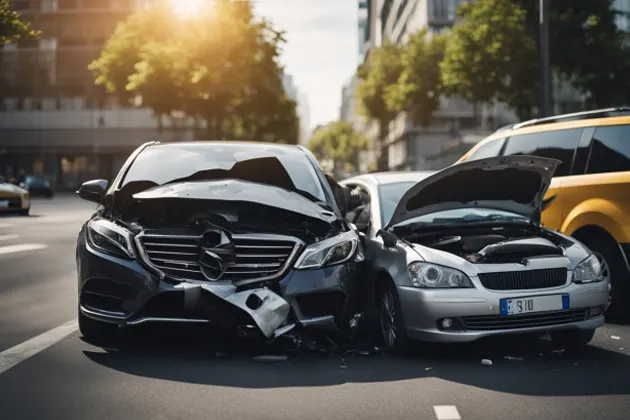Car accidents can lead to significant physical, emotional, and financial challenges for victims. Understanding legal rights and compensation options is crucial for anyone affected by such incidents, as it empowers them to seek justice and recovery. Many individuals are unaware of the various entitlements available, which can greatly affect their ability to navigate the aftermath of a car accident.
Victims often face mounting medical bills, property damage, and lost wages. Knowing the legal process can help ensure that they receive the compensation they deserve. From insurance claims to potential lawsuits, the pathways to recovery can be complex, but knowledge serves as a powerful tool in ensuring fair treatment.
Fundamentals of Car Accident Law
Negligence and Fault
Negligence is a vital concept in car accident cases. It refers to a failure to exercise reasonable care, resulting in harm to others. To prove negligence, the victim must establish four elements: duty of care, breach of that duty, causation, and damages. Examples of negligence include:
- Distracted driving (e.g., texting)
- Speeding and reckless driving
- Driving under the influence of drugs or alcohol
Fault can be shared among multiple parties. In such scenarios, jurisdictions may apply comparative negligence rules to determine compensation. Victims should be aware of their state’s laws, as they can significantly impact the outcome of a case.
Types of Car Accidents
Car accidents can take various forms, each with unique implications for liability. Common types include:
- Rear-end collisions: Often caused by distractions or following too closely.
- Side-impact (T-bone) accidents: These typically occur at intersections, frequently due to running a red light.
- Head-on collisions: These are usually severe, often resulting from one vehicle crossing into oncoming traffic.
Each type of accident has specific factors that determine liability. Understanding these distinctions helps victims prepare their cases more effectively.
Determining Liability
Liability in car accidents requires a careful assessment of the circumstances involved. Factors include traffic laws, the actions of the involved drivers, and any external conditions, such as weather or road maintenance.
In many cases, evidence such as police reports, witness statements, and traffic camera footage plays a significant role. Key points to consider include:
- Was the driver following traffic laws?
- Did any external factors contribute to the accident?
- Were there any violations of state statutes?
Establishing clear liability helps victims seek appropriate compensation for damages, such as medical expenses and property loss.
Rights of Car Accident Victims
Car accident victims have specific legal rights that can aid in their recovery. Understanding these rights is essential for ensuring fair compensation and navigating the aftermath of an accident effectively.
Right to Compensation
Victims of car accidents have the right to seek compensation for various damages. This may include medical expenses, lost wages, and property damage. Emotional distress and pain and suffering can also be included in claims.
To establish a claim, victims typically need to prove that the other party was negligent. This evidence can include police reports, witness statements, and medical records. It’s crucial to document all related expenses and losses thoroughly.
Statute of Limitations
Each state has a statute of limitations that dictates the time frame for filing a claim. This period usually ranges from one to six years, depending on the jurisdiction. Filing a claim after this deadline can result in losing the right to seek compensation.
Victims must be aware of these time limits and take prompt action if pursuing a claim. An attorney can provide clarity on the specific laws applicable to the case. This step ensures that victims do not miss critical deadlines.
Dealing with Insurance Companies
Navigating the insurance claims process can be challenging for car accident victims. Insurance companies often attempt to minimize payouts. Victims have the right to negotiate their claims and seek a fair settlement.
Providing all required documentation and evidence is essential in these negotiations. Victims should be cautious about accepting initial offers, as they may undervalue the claim. Legal representation can assist in securing a more equitable settlement and ensuring that victims’ rights are upheld.
Personal Injury Claims
Personal injury claims are essential for victims seeking compensation after a car accident. These claims allow individuals to recover costs related to medical expenses, lost wages, and other damages caused by negligence.
Filing a Claim
Filing a personal injury claim begins with gathering relevant evidence. Victims should collect police reports, medical records, and witness statements. This documentation strengthens their case and provides a clear picture of the accident.
Next, the individual must notify the insurance company of the intent to file a claim. This notification typically requires a written statement detailing the accident and related damages. It is crucial to adhere to any deadlines, as missing them can lead to a claim denial.
Claim Process
The claim process follows several key steps. After filing, the insurance adjuster reviews all evidence and may contact the accident victim for additional information. They may also conduct interviews with witnesses or consult medical professionals.
During the evaluation, the adjuster determines the validity of the claim and the extent of damages. This process can take time, often involving negotiations between the victim and the insurance company. Communication is essential to address any concerns or questions that arise.
Settlements
Settlement negotiations often begin after the claim is assessed. Victims may receive an initial offer from the insurance company, which may be lower than expected. To reach a fair agreement, the victim may need to counteroffer and provide additional evidence supporting their claim.
It is advisable for victims to consult a personal injury attorney during this stage. Legal representation can help negotiate better terms and ensure that all potential damages are considered. Settlements aim to compensate victims fairly while avoiding the lengthy process of litigation.
Compensation Elements
Victims of car accidents may seek various forms of compensation based on their specific circumstances. Key components typically include medical expenses, lost wages, and pain and suffering. Each element plays a crucial role in securing a fair resolution for the affected individual.
Medical Expenses
Medical expenses cover costs related to the treatment of injuries sustained in the accident. This includes hospital bills, surgeries, rehabilitation, and ongoing therapy. Victims can also claim costs for medications and any necessary medical devices.
It is essential to keep detailed records and invoices of all medical treatments. This information supports claims and ensures that all expenses are accounted for.
Lost Wages
Lost wages represent the income an individual loses due to their inability to work after an accident. Calculating lost wages involves determining the victim’s average earnings during the period of incapacity. This includes salary, hourly wages, or even bonuses.
In some cases, lost future earning capacity may also be included if injuries lead to long-term limitations on employment options. Documentation from employers and pay stubs can substantiate these claims.
Pain and Suffering
Pain and suffering refer to the physical and emotional distress caused by the accident. This element covers the immediate pain and any long-term effects on the victim’s quality of life.
Calculating pain and suffering often involves subjective assessments. Factors include the severity of injuries, recovery time, and impact on daily activities. Victims may need to provide testimony or expert evaluations to support their claims for this type of compensation.
Treatment and Recovery
Prompt and appropriate medical attention is crucial for car accident victims. The effectiveness of treatment can significantly influence both short-term recovery and long-term well-being.
Immediate Medical Care
After an accident, it is vital for individuals to seek immediate medical care. This may include a trip to the emergency room or contact with a healthcare professional. Medical evaluations can identify critical injuries, including internal bleeding, fractures, or head trauma. Key aspects of immediate care include:
- Assessment of Injuries: Doctors will conduct thorough assessments, often involving imaging tests like X-rays or CT scans.
- Stabilization: Patients may receive vital interventions to address life-threatening conditions.
- Pain Management: Immediate relief through medications can be provided.
Following initial evaluations, doctors will recommend a treatment plan that might involve surgery or specialized care.
Long-Term Rehabilitation
Recovery from car accidents often requires long-term rehabilitation, depending on the severity of injuries sustained. Rehabilitation focuses on restoring function and improving the quality of life. Components of long-term rehabilitation include:
- Physical Therapy: Tailored plans to strengthen muscles, improve mobility, and relieve pain.
- Occupational Therapy: Assistance with daily activities to regain independence.
- Psychological Support: Counseling may be necessary to address emotional trauma.
Continued follow-ups with medical professionals ensure that progress is monitored and adjustments to treatment plans are made accordingly. This holistic approach aims to facilitate a comprehensive recovery.
Legal Process and Proceedings
Understanding the legal journey for car accident victims involves several critical steps. This includes hiring the right legal representation, navigating pre-trial procedures, and preparing for potential trials.
Hiring an Attorney
Selecting an attorney with experience in personal injury law is essential. They can provide invaluable guidance and support throughout the claims process.
Victims should seek lawyers who specialize in car accident cases and have a successful track record. A good attorney will conduct a thorough investigation, gather evidence, and evaluate the damages.
A contingency fee arrangement can help victims manage costs. This means the attorney only receives payment if the case is successful, ensuring alignment of interests between the client and the lawyer.
Pre-Trial Procedures
Pre-trial procedures involve several key steps that set the foundation for a case. After hiring an attorney, they will file a complaint, detailing the damages sought and the reasons for the claim.
Both parties engage in discovery, where they exchange information and gather evidence. This may include documents, photographs, and witness statements. A deposition may also take place, where witnesses provide sworn testimony.
Settlement negotiations often occur during this stage. Insurance companies may propose settlements to avoid trial, and accepting a fair offer can expedite compensation for victims without the need for lengthy court proceedings.
Trial and Verdict
If a settlement is not reached, the case may proceed to trial. At this stage, both parties present their arguments, evidence, and witness testimonies before a judge or jury.
The trial process includes opening statements, examination of witnesses, and closing arguments. Each side aims to persuade the judge or jury of their position regarding liability and damages.
After deliberation, a verdict is reached. If the plaintiff prevails, the court will determine the appropriate compensation. If the verdict is unfavorable, there may be options for appeal depending on the circumstances surrounding the case.
Evidence and Documentation
Collecting thorough evidence and documentation is crucial for car accident victims seeking compensation. Properly assembled information can strengthen a case, clarify events leading up to the incident, and substantiate claims.
Collecting Evidence
Accident victims should promptly gather evidence at the scene. This includes taking clear photographs of vehicle damage, road conditions, and any relevant traffic signs. Noting the time and location helps establish context.
Documentation of injuries is essential. This can entail photographs of injuries and medical records detailing treatment received. Victims should keep records of any expenses incurred as a result of the accident, including medical bills and repair costs.
Additionally, victims should have the other party’s insurance details and contact information. This streamlines the process of filing claims and seeking compensation.
Accident Report
An accident report, typically created by law enforcement, provides an official account of the incident. It includes essential information such as the date, time, and location of the accident, along with details on involved parties.
Victims should obtain a copy of this report, as it can serve as a vital piece of evidence. The report may also contain witness statements and officer observations that can support claims. Discrepancies between the report and personal accounts should be noted and addressed with authorities.
Understanding the terminology and findings in the report is important for legal processes. This document plays a critical role when negotiating with insurance companies or pursuing legal action.
Witness Statements
Witness statements can add significant weight to a car accident case. Eyewitness accounts often provide impartial perspectives on what transpired, helping to corroborate claims made by victims.
Victims should collect contact information from witnesses immediately. Ideally, witnesses should provide written statements detailing what they observed. This documentation should be factual and free from personal opinions.
In some cases, witnesses may be willing to testify if legal action ensues. Victims should maintain open lines of communication with these witnesses to ensure their statements remain accessible. These accounts can shape the outcome of insurance negotiations or court cases.
Working with Law Enforcement
Effective collaboration with law enforcement is crucial for car accident victims. Understanding police reports and the investigation process helps victims navigate the aftermath of an accident and secure necessary documentation for their cases.
Police Reports
A police report is an essential document after a car accident. It contains vital information, including the details of the incident, involved parties, and witness statements.
Victims should obtain a copy of the police report as soon as possible. This report serves as an official record and may play a significant role in insurance claims. Key elements typically included are:
- Officer details
- Accident location
- Date and time of the incident
- Circumstantial accounts from witnesses
Having an accurate police report can strengthen a victim’s case, especially in disputes regarding fault or damages.
Investigation Process
The investigation process begins immediately after a car accident. Law enforcement officers will assess the scene, gather evidence, and interview those involved.
This process aims to establish facts about the accident. Officers gather information such as skid marks, vehicle positions, and eyewitness accounts.
Victims may be asked to provide their statements, which should be clear and concise. Important factors considered include:
- Traffic laws
- Weather conditions
- Statements from all parties involved
Accurate investigations not only clarify the circumstances but also aid in determining liability. This is vital for victims seeking compensation.
Alternative Dispute Resolution
Alternative dispute resolution (ADR) offers car accident victims a means to resolve their claims without resorting to litigation. This process includes mediation and arbitration, each providing distinct paths toward resolution.
Mediation
Mediation involves a neutral third-party mediator who facilitates discussions between the parties involved in the dispute. The mediator does not make binding decisions but helps guide the conversation toward a mutually acceptable agreement. Key benefits of mediation include:
- Confidentiality: Discussions remain private, protecting the interests of both parties.
- Control: Parties retain control over the outcome, fostering a more satisfactory resolution.
- Cost-effective: This process generally incurs lower costs than traditional litigation.
Mediation can be especially beneficial for car accident victims seeking to expedite resolution without the unpredictability of court proceedings.
Arbitration
Arbitration involves presenting the dispute to an arbitrator or a panel who evaluates the evidence and makes a binding decision. This process is more formal than mediation but less so than court action. Important aspects of arbitration include:
- Binding Decision: The arbitrator’s decision is final and usually enforceable in court.
- Speed: Arbitration often resolves disputes more quickly than the court system.
- Less Formality: The process is generally more streamlined and can be less intimidating.
For car accident victims, arbitration offers a structured approach that can lead to a quicker resolution of their claims while ensuring that the outcome is legally enforceable.
Special Considerations
Car accident victims may encounter unique circumstances that affect their claims. Areas such as wrongful death claims, product liability, and government entities’ liability require specific attention. Each situation holds distinct legal nuances that can significantly influence the pursuit of compensation.
Wrongful Death Claims
In cases where a car accident leads to a fatality, the deceased’s family may file a wrongful death claim. This type of claim allows them to seek compensation for losses experienced due to the individual’s death. Eligible family members typically include spouses, children, or parents, depending on state laws. Key components of a wrongful death claim include:
- Proving negligence: Claimants must establish that another party’s negligent actions caused the accident.
- Calculating damages: Compensation may cover medical expenses, funeral costs, loss of companionship, and lost income.
- State-specific statutes: Families should be aware of the statute of limitations, as this varies by location.
Product Liability
When a car accident results from defective vehicle parts, a product liability claim may arise. Victims can seek compensation from manufacturers, distributors, or retailers. These claims hinge on proving that a defect in the product directly caused the accident. Important aspects of product liability include:
- Types of defects: Claims may arise from design flaws, manufacturing defects, or inadequate warnings.
- Burden of proof: Victims must demonstrate how the defect contributed to the accident and their injuries.
- Potential for multiple defendants: Various parties in the supply chain may be held responsible.
Government Entities Liability
Accidents involving government entities, such as public transit vehicles or poorly maintained roads, introduce specific legal considerations. Victims may seek compensation from the responsible governmental body, but special rules often apply. Factors to consider in government liability include the following:
- Notice requirements: Many jurisdictions require victims to file a formal notice of claim within a specific timeframe.
- Sovereign immunity: Governments may be protected from liability unless a waiver exists, limiting the circumstances under which claims can be made.
- Public vs. private responsibility: Understanding the distinctions in liability can affect the strategy for pursuing compensation.
Financial Impact of Car Accidents
Car accidents can lead to significant financial burdens for victims. The costs associated with these incidents extend beyond immediate medical expenses and vehicle repairs. Two primary areas of impact are insurance premiums and tax consequences.
Insurance Premiums
Following a car accident, insurance premiums may increase. Insurers often view claims as indicators of higher risk. Victims may experience hikes in their rates, reflecting the perceived likelihood of future accidents.
For example, a study shows that premiums can increase by an average of 30% after a claim. This rise can affect the victim’s budget for years to come. Additionally, minor accidents without injuries can still trigger premium increases. Here are some tips to manage increasing premiums:
- Shop Around: Compare rates from different insurers.
- Consider a Higher Deductible: This may lower monthly premiums.
- Take a Defensive Driving Course: Some insurers offer discounts for completed courses.
Tax Consequences
Car accident victims might face tax implications that can further complicate their financial situation. Compensation received for injuries is generally non-taxable. However, other financial aspects may be subject to taxes.
For instance, if a victim receives compensation for lost wages, those funds can be taxable. Furthermore, any punitive damages awarded during a lawsuit are also taxable. It’s essential for victims to report any applicable compensation on their tax returns accurately. Important considerations include:
- Track all compensation received: Accurate records help clarify tax obligations.
- Consult a tax professional: A specialist can provide guidance specific to individual circumstances.
These components illustrate the broader financial impact that car accidents can impose on victims and their families.
Car Accident Prevention
Preventing car accidents involves adopting safe driving practices and utilizing vehicle safety features. By focusing on these areas, drivers can significantly reduce the likelihood of collisions and ensure safer roadways.
Safe Driving Practices
Adopting safe driving habits is crucial. Key practices include:
- Avoiding Distractions: Limit phone use and other distractions while driving.
- Adhering to Speed Limits: Speeding increases the severity of accidents. Following speed limits helps maintain control.
- Using Turn Signals: Proper signaling informs other drivers of intentions, reducing the chance of accidents.
- Maintaining a Safe Following Distance: Keeping a safe distance provides ample reaction time if the vehicle ahead stops suddenly.
Drivers should also avoid impaired driving. Using alcohol, drugs, or even certain medications can impair reaction times and decision-making.
Vehicle Safety Features
Modern vehicles come equipped with various safety features designed to prevent accidents. Important features include:
- Anti-lock Braking System (ABS): Helps maintain steering control during hard braking.
- Electronic Stability Control (ESC): Assists drivers in maintaining control during slippery conditions.
- Lane Departure Warning (LDW): Alerts drivers when veering out of their lane without signaling.
- Adaptive Cruise Control: Automatically adjusts the vehicle’s speed to maintain a safe distance from the car ahead.
Understanding and utilizing these features can greatly enhance driving safety and reduce accident risk. Regular maintenance of these systems is also essential for optimal performance.
Post-Accident Checklist
Knowing the essential steps to take after a car accident can significantly impact the outcome of any claims. The following points outline crucial immediate actions and important follow-up steps.
Immediate Steps After an Accident
- Ensure Safety: The first priority is to check for injuries. If safe, move vehicles to a secure location to prevent further accidents.
- Call Emergency Services: Dial 911 for medical assistance if there are any injuries. The police should also be notified to document the accident.
- Exchange Information: Collect names, contact details, insurance information, and license plate numbers from all involved parties.
- Document the Scene: Take photos of vehicle damage, the accident scene, and any relevant traffic signs. Note the date and time.
- Avoid Admitting Fault: Do not discuss fault at the scene. Stick to the facts when speaking with others, including law enforcement.
Follow-Up Actions
- Seek Medical Attention: Even if injuries seem minor, seeing a healthcare provider is crucial. Some injuries may not be immediately apparent.
- Notify Insurance Companies: Report the incident to insurers promptly. Provide them with all required details and documents related to the accident.
- Keep Records: Maintain a file of all related documents, including medical records, repair estimates, and correspondences with insurers.
- Consult an Attorney: If needed, an attorney can offer guidance on legal rights and potential compensation options related to the accident.
Follow Medical Recommendations: Adhere to treatment plans and follow-up appointments to ensure your recovery and support any claims.










